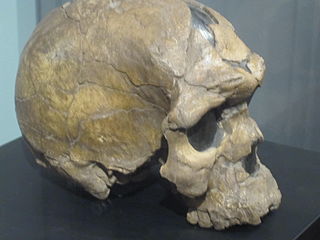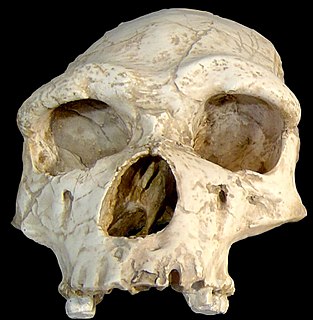
Human evolution is the evolutionary process that led to the emergence of anatomically modern humans, beginning with the evolutionary history of primates—in particular genus Homo—and leading to the emergence of Homo sapiens as a distinct species of the hominid family, the great apes. This process involved the gradual development of traits such as human bipedalism and language, as well as interbreeding with other hominins, which indicate that human evolution was not linear but a web.

Australopithecus is a genus of hominins that existed in Africa from around 4.2 to 1.9 million years ago and from which the Homo genus, including modern humans, is considered to be descended. Australopithecus is a member of the subtribe Australopithecina, which includes Paranthropus, Kenyanthropus, Ardipithecus and Praeanthropus, though the term "australopithecine" is sometimes used to refer only to members of Australopithecus.

Homo sapiens is the only extant human species. The name is Latin for 'wise man' and was introduced in 1758 by Carl Linnaeus.

Homo ergaster, also Homo erectus ergaster or African Homo erectus, is an extinct chronospecies of the genus Homo that lived in eastern and southern Africa during the early Pleistocene, between about 1.9 million and 1.4 million years ago.

Homo heidelbergensis is an extinct species or subspecies of archaic humans in the genus Homo, which radiated in the Middle Pleistocene from about 700,000 to 300,000 years ago. African H. heidelbergensis has 4 subspecies: H. h. heidelbergensis, H. h. daliensis, H. h. rhodesiensis, and H. h. steinheimensis. The derivation of H. sapiens from H. rhodesiensis has often been proposed, but is obscured by a fossil gap from 400–260 kya. The species was originally named Homo heidelbergensis due to the skeleton's first discovery near Heidelberg, Germany.

Homo sapiens idaltu, also called Herto Man, is the name given to a number of early modern human fossils found in 1997 in Herto Bouri, Ethiopia. They date to around 160,000 years ago.

Homo is the genus that emerged in the otherwise extinct genus Australopithecus that encompasses the extant species Homo sapiens, plus several extinct species classified as either ancestral to or closely related to modern humans, most notably Homo erectus and Homo neanderthalensis. The genus emerged with the appearance of Homo habilis, just over 2 million years ago. Homo, together with the genus Paranthropus, is probably sister to Australopithecus africanus, which itself had previously split from the lineage of Pan, the chimpanzees.

Homo floresiensis is a pygmy archaic human which inhabited the island of Flores, Indonesia, until the arrival of modern humans about 50,000 years ago.

Homo rhodesiensis is the species name proposed by Arthur Smith Woodward (1921) to classify Kabwe 1, a Middle Stone Age fossil recovered from a cave at Broken Hill, or Kabwe, Northern Rhodesia.

Human taxonomy is the classification of the human species within zoological taxonomy. The systematic genus, Homo, is designed to include both anatomically modern humans and extinct varieties of archaic humans. Current humans have been designated as subspecies Homo sapiens sapiens, differentiated according to some from the direct ancestor, Homo sapiens idaltu.

Tabon Man refers to remains discovered in the Tabon Caves in Lipuun Point in Quezon, Palawan in the Philippines. They were discovered by Robert B. Fox, an American anthropologist of the National Museum of the Philippines, on May 28, 1962. These remains, the fossilized fragments of a skull of a female and the jawbones of three individuals, were believed to be the earliest human remains known in the Philippines, which date back to 16,500 years ago, until a metatarsal from the Callao Man discovered in 2007 was dated in 2010 by uranium-series dating as being 67,000 years old. However, some scientists think additional evidence is necessary to confirm those fossils as a new species, rather than a locally adapted population of other Homo populations, such as H. erectus or Denisovan.

The South Asian Stone Age covers the Palaeolithic, Mesolithic and Neolithic periods in South Asia. Evidence for the most ancient anatomically modern Homo sapiens in South Asia has been found in the cave sites of Cudappah of India, Batadombalena and Belilena in Sri Lanka. In Mehrgarh, in what is today western Pakistan, the Neolithic began c. 7000 BCE and lasted until 3300 BCE and the first beginnings of the Bronze Age. In South India, the Mesolithic lasted until 3000 BCE, and the Neolithic until 1400 BCE, followed by a Megalithic transitional period mostly skipping the Bronze Age. The Iron Age began roughly simultaneously in North and South India, around c. 1200 to 1000 BCE.
The name Dali man refers to the remains of a late Homo erectus or archaic Homo sapiens, who lived in the late-mid Pleistocene epoch. The remains comprise a complete fossilized skull, which was discovered by Liu Shuntang in 1978 in Dali County, Shaanxi Province, China.

Jebel Irhoud is an archaeological site located just north of the locality known as Tlet Ighoud, about 50 km (30 mi) south-east of the city of Safi in Morocco. It is noted for the hominin fossils that have been found there since the site's discovery in 1960. Originally thought to be Neanderthals, the specimens have since been assigned to an archaic or "early" Homo sapiens and have been dated to roughly 300,000 years ago.
Homo erectus were a species of archaic humans from the Pleistocene, earliest occurrence about 2 mya. They are proposed to be the direct ancestors to several human species, such as H. heidelbergensis, H. antecessor, Neanderthals, Denisovans, and modern humans. As a chronospecies, the time of its disappearance is thus a matter of contention or even convention. There are also several proposed subspecies with varying levels of recognition.

Tautavel Man is a proposed subspecies of Homo erectus, the type specimen being 450,000-year-old fossil remains discovered in the Arago Cave in Tautavel, France. Excavations began in 1964, with the first notable discovery occurring in 1969.

Misliya cave, also known as Brotzen Cave after Fritz Brotzen who first described it in 1927, is a collapsed cave at Mount Carmel, Israel, containing archaeological layers from the Lower Paleolithic and Middle Paleolithic periods. The site is significant in paleoanthropology for the discovery of what were, from 2018 to 2019, considered to be the earliest known remains attributed to Homo sapiens outside of Africa, dated to 185,000 years ago.

The Apidima Cave is a complex of four small caves located on the western shore of Mani Peninsula in southern Greece. A systematic investigation of the cave has yielded Neanderthal and Homo sapiens fossils from the Palaeolithic era.
Hualong Cave is a cave in Pangwang village in Dongzhi County, Anhui Province, China, and situated on the southern bank of Yangtze. It is located on the side of Meiyuan Hill. Palaeontological interest started in 2004 when a farmer accidentally found bones that were later identified as mammalian fossils. Excavations started in 2006 by paleontologists from the Chinese Academy of Sciences. It has yielded many stone tools and over 30 human fossils, and animal bones including those of Ailuropoda, Arctonyx, Bubalus, Sinomegaceros, Stegodon, giant tapir, and giant pandas. The most notable fossils are that of a Homo erectus described in 2014, and that of a 300,000-year-old archaic human discovered in 2019.















